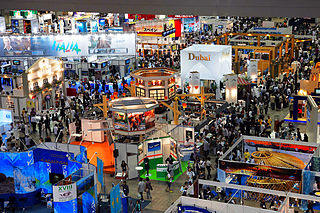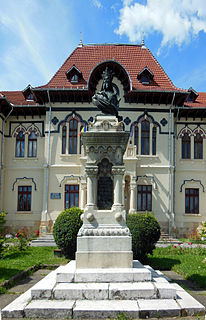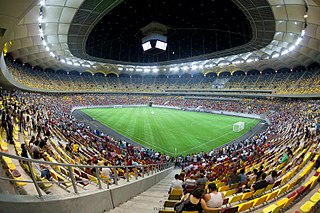A târg was a medieval Romanian periodic fair or a market town. Originally established on the places where periodic fairs were held, some of them (but not all) became permanent settlements, [1] as craftsmen built their workshops near the place where the fair was held.

Romania is a country located at the crossroads of Central, Eastern, and Southeastern Europe. It borders the Black Sea to the southeast, Bulgaria to the south, Ukraine to the north, Hungary to the west, Serbia to the southwest, and Moldova to the east. It has a predominantly temperate-continental climate. With a total area of 238,397 square kilometres (92,046 sq mi), Romania is the 12th largest country and also the 7th most populous member state of the European Union, having almost 20 million inhabitants. Its capital and largest city is Bucharest, and other major urban areas include Cluj-Napoca, Timișoara, Iași, Constanța, Craiova, and Brașov.

Market town or market right is a legal term, originating in the Middle Ages, for a European settlement that has the right to host markets, distinguishing it from a village and city. On the European continent, a town may be correctly described as a "market town" or as having "market rights", even if it no longer holds a market, provided the legal right to do so still exists.

A fair, also known as a funfair, is a gathering of people for a variety of entertainment or commercial activities. It is normally of the essence of a fair that it is temporary with scheduled times lasting from an afternoon to several weeks.
Contents
The market towns were still largely agricultural, with the lord of the settlement allowing some inhabitants to become tradesmen or craftsmen in exchange of some fees. [2] Some of the towns were fortified and became known as cities or fortresses (cetăți).
Many of the earliest fairs were named after the river that flowed nearby. Examples include:
- Târgul Moldovei, on Moldova River (currently known as Baia)
- Târgu Mureș, on Mureș River
- Târgu Jiu, on Jiu River
- Târgul Argeşului, on Argeș River (currently known as Curtea de Argeş)
- Târgu Neamț, on Neamț River
- Târgu Lăpuș, on Lăpuș River
- Cetatea Dâmboviței, on Dâmbovița River (historical name for Bucharest)
- Cetatea Sucevei, on Suceava River (currently known as Suceava)
- Târgul Bârladului, on Bârlad River (currently known as Bârlad)
- Târgul Siretului, on Siret River (currently known as Siret)

Baia is a commune in the Suceava County, Romania with a population of 6,793. It is composed of two villages, Baia, and Bogata. Located on the Moldova River, it was one of the earliest urban settlements in Moldavia.

The Moldova River is a river in Romania, in the historical region of Moldavia. It is a right tributary of the river Siret. The river rises from the Obcina Feredeu Mountains of Bukovina in Suceava County and joins the Siret near the city of Roman in Neamț County. The total length of the Moldova from its source to its confluence with the Siret is 213 km (132 mi). Its basin area is 4,299 km2 (1,660 sq mi).

Târgu Mureș is the seat of Mureș County in the north-central part of Romania. It is the 16th largest Romanian city, with 134,290 inhabitants as of the 2011 census. It lies on the Mureș river, the second longest river in Romania.












